Schemes and descriptions for them for two-color crochet patterns are used both to create clothes and to decorate the interior (for example, tablecloths, napkins, etc.) The working tools used are a hook, yarn, and sometimes threads, fingers, or pins.
Necessary tools and materials
Beginners choose patterns and descriptions for two-color crochet patterns based on the level of complexity of execution, but the success of the work done is often influenced not only by the pattern, but also by the tools and materials.
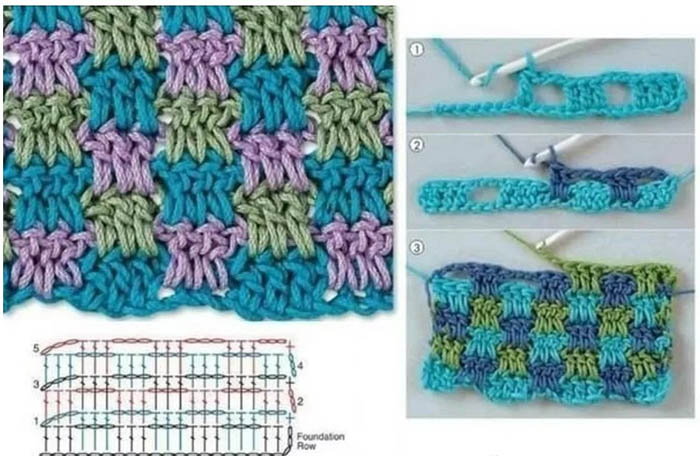
Tips for choosing materials for beginners.
| Thread of yarn |
|
| Hook |
|
| Selecting yarn for a hook |
|
Schemes with description of works for beginners
Two-color crochet patterns (diagrams and descriptions are described in detail in the master classes below) in most cases imply regular patterns with the use of 2 or 3 additional colored threads. This is done to give the pattern volume, depth or to make the fabric more colorful.
Two-tone braids
The simplest and most suitable for beginners is considered to be the “braid” pattern, in which 2 different colors are intertwined. The shades are chosen at your discretion, in the example pink and white yarn is used.
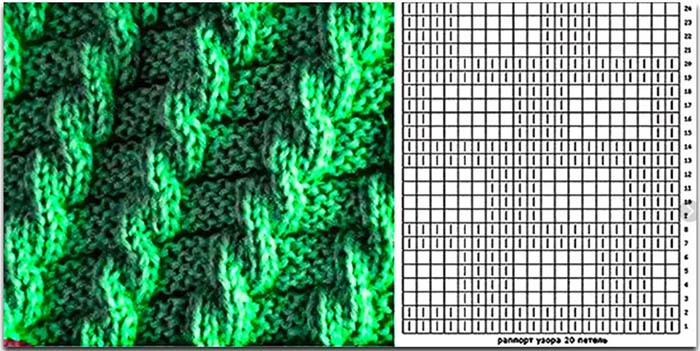
The knitting process includes the following steps.
- Using a small hook, knit a chain of air loops from pink yarn. Then step back 6 loops, make the 7th loop a column with 3 yarns. Do the same with the next loop in the row (make 3 yarns, pass the thread through the adjacent loop, carefully knit a column). Knit 3 air loops further in the row.
- Count 3 loops in the initial section of air loops and in the 4th loop knit a column with 3 yarns. In the loop adjacent to the 3rd loop make 1 column using 3 yarns. You get a repeating pattern of 2 columns with 3 yarns, located at an equal distance. This is how the row ends.
- Use a thread of a different color when the base is finished. Find a loop at the base of every 2nd column and attach the end of the white thread to it, knit 6 air loops. Then make 3 yarn overs and from the next air chain at the beginning of knitting knit a column. Also knit the last loop at the base. This pattern fills the empty space between the pink columns.
- When you have finished filling with white thread, knit 3 air loops. Next: 3 yarn overs, this column is knitted into the next free loop of the row (4th loop after the 2nd pink column).
- Knit with white threads using the same algorithm. As a result, you get 2 canvases of different colors.
- Knitting is turned over and the same algorithm is performed in the opposite direction. Start knitting from the loop that ended the previous row, use white yarn. Make 6 air loops, 3 yarns on the hook, pull the hook with the thread under the chain of air pink loops and knit up 2 white columns.
- The next column is knitted similarly with 3 yarns - the hook is inserted under the chain of pink loops and a column with 3 yarns is knitted into a free loop on the chain of white loops. The algorithm is repeated until the end of the row.
- The next row is knitted with pink threads from the top of the 1st column in the row that was made first. At this stage, the entire algorithm is repeated with white threads.
- Repeat the entire pattern from the beginning.
Japanese pattern
A three-dimensional pattern using 2 colors is suitable for creating wardrobe items or for interior decoration. The example uses white and blue yarn, but they can be replaced with any other.
First, use white threads to make a chain of air loops, their number should be a multiple of 6, and add 3 more loops.
Then proceed according to the scheme.
| Row | Algorithm |
| 1 (white yarn) | 1. Make a chain stitch with a lift, 3 single crochets. 2. 7 air loops, 3 base loops and in the next 3 loops of the row knit 1 single crochet. Repeat this algorithm to the end. |
| 2 (blue yarn) | 1. From the 1st base loop, make 2 air loops with a rise, in the next 2 loops of the row, make 1 half-column with a yarn over, then 3 half-columns with a yarn over are knitted with a chain from the air loop of the previous row in the initial chain. Then make 3 half-columns in a single crochet from the previous row.
2. Next, make 3 half-columns in a chain from the air loop of the previous row into the loops of the original chain, 3 half-columns in a single crochet of the previous row. Repeat this order until the end of the row. |
| 3 (blue yarn) | Make an air loop with a lift, from the 1st loop of the base make 1 column without a yarn in each loop. Repeat until the end. |
| 4 (white yarn) | 1. Knit 3 air loops with a lift, then 3 double crochets from the 1st base loop.
2. 3 air loops, 1 single crochet into the chain of air loops of the 1st row, 3 air loops, skip 3 base loops, knit 3 double crochets. Repeat the algorithm to the end. |
| 5 (white yarn) | 1. 1 air loop with lifting, 3 columns without a yarn over a column with a yarn from the previous row.
2. 7 air loops, 3 single crochets over the double crochet from the previous row. Repeat the algorithm until the end of the row. |
| 6 (blue yarn) | 1. 3 air loops with lifting, 3 columns without a yarn from the 1st base loop.
2. Make 3 extended double crochet stitches behind the chain of air loops of the previous row at the tops of the columns of the 3rd row, 3 single crochet stitches above the single crochet stitch of the previous row. Repeat the algorithm to the end. |
| 7 (blue yarn) | Repeat the pattern from 3-6 rows. |
Rhombuses with flowers
A simple and quick to execute pattern is suitable for knitting clothes. The example uses white and green threads, but they can be replaced with any others. The pattern contains abbreviations denoting the initial letters (VP - air loop, SN - column with a yarn over, SC - column without a yarn over, P - skip).
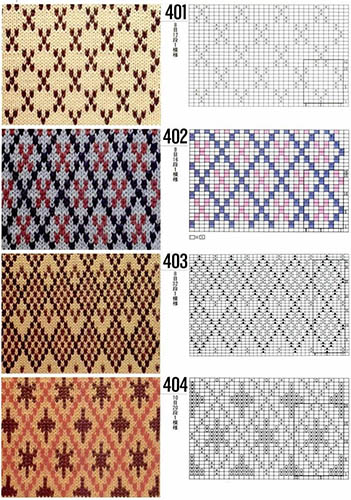
The knitting sequence includes the following steps.
| Row | Algorithm |
| 1 (green yarn) | A chain of air loops is formed. |
| 2 (white thread) | 1. Attach the light thread to the dark loop. Make 3 VP with a lift, 2 SN, 2 VP, 2 P, 3 SN, 2 VP, 2 P, 3 SN. Alternate until the end of the row. 2. Pull out a large loop without breaking the thread. |
| 3 (green yarn) | 1. Attach the green thread to the light one.
2. 3 VP, 1 SC between 2 dc from the previous row, 2 VP, 1 SC, 2 VP, 1 SC, 2 VP. Continue alternating to the end. (SC are knitted not into a loop, but between the columns from the previous row). 3. Pull out a large loop to hold the fabric. |
| 4 (white yarn) | 1. 3 VP, 3 SN under 2 arches of previous rows, 2 VP, 3 SN, 2 VP. Continue alternating until the end.
2. Pull out the loop. |
| 5 (green yarn) | Repeat the row as in the algorithm of the 3rd row and then alternate the 3rd and 4th rows. |
Stars
Two-color crochet patterns (diagrams and descriptions do not always indicate the use of different colors, but even a monotonous pattern is diluted with yarn of a different color) are recommended to be combined with different yarn. For a star pattern, you can use acrylic threads (200 m by 50 g). A hook size 2.5 is suitable for such a thread.
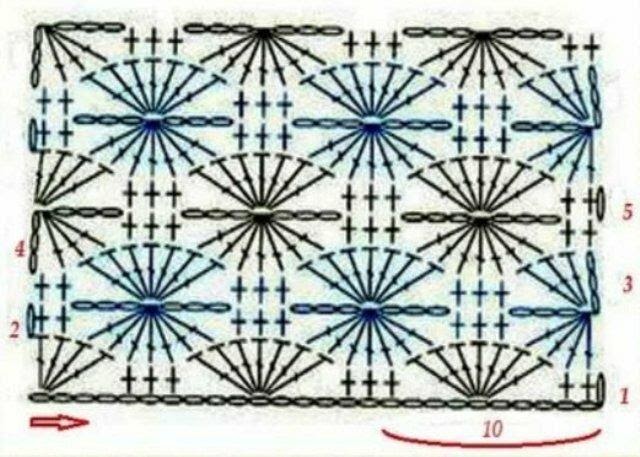
The knitting process is carried out according to the following scheme. All designations are indicated by abbreviations (VP - air loop, SC - single crochet, SN - double crochet, P - skip). In the 1st and 2nd rows, use a thread of the same color.
Then the color is changed every 2 rows.
- Cast on stitches that are multiples of 10 and 7 additional stitches.
- 1 P, 1 SC, 3 P, 7 dc, 3 P, 3 SC, 7 dc. In the last loop of the chain, knit 4 dc.
- This and the next row are knitted in one color. 1 PP, turn the knitting over and in the same loop 1 sc, 3 VP. Subtract 7 columns: 2 halves of dc in the next loops, 3 halves of dc in 3 loops, 2 halves of dc in 2 loops of the new fan of the previous row. Collect 8 loops on the hook: 7 from untied dc and 1 working. Close all loops (yarn over the hook and pull it through all the loops). Knit 3 VP, 3 sc, 3 VP and again decrease from 7 dc. At the end of the row, decrease 4 dc.
- 3 PP and in the same loop 3 SN, 3 SC in 3 columns of the previous row. In the middle of the decrease from the previous row, make a fan of 7 SN. Continue the algorithm. At the end of the row, 2 SC in a row.
- Change the thread and knit the 5th and 6th rows with it. 3 PP, decrease 3 SN from the next 3 loops, 3 VP, 3 SC, 3 VP, decrease from 7 SN. At the end of the row after the last decrease, knit 2 SC in a row.
- Knit into the centers of the fan.
- Repeat the algorithm of the 2nd row, change the thread and repeat the entire algorithm for the next rows.
Fence
Two-color crochet patterns (the diagrams and description in the instructions suggest using a certain color pair, but they can be changed at your discretion) often seem difficult to do, but the “fence” pattern is done quickly. Its algorithm can be easily mastered by beginner knitters.
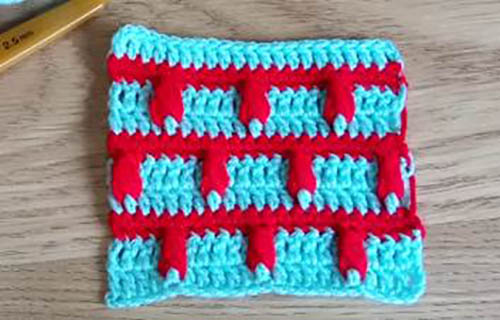
For the base of the fabric, it is recommended to use lighter shades of yarn, and for the pattern, choose a bright or darker thread. For the star pattern, you can use acrylic threads (200 m by 50 g). A hook size 2.5 is suitable for such a thread.
In the process, knit 2 rows of double crochets with yarn of one color, then 2 rows with yarn of another color. First, dial air loops, the number of which should be equal to 6 and add another 6 loops.
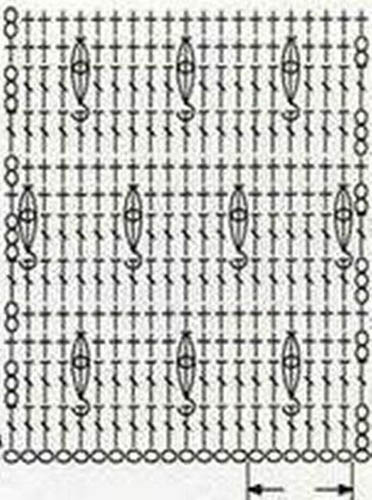
The knitting process is carried out according to the following scheme. All designations are indicated by abbreviations (VP - air loop, SC - single crochet, SN - double crochet, PS - lush column).
| Row | Algorithm |
| 1 (light yarn) | 1. Knit a chain of 24 loops. 2. Skip 4 loops, from the 5th dc in each loop. |
| 2 (light yarn) | 3 loops with lifting, turn the fabric over and continue knitting from the next loop, make a dc in each. |
| 3 (dark yarn) | 1. Knit 1 loop with a lift, turn the fabric over. In the same loop, knit 1 sc.
2. Next, make 3 sc in a row. 3. Then a PS of 3 SN. It is knitted for the base of the column from the first row: make a yarn over on the hook and put it behind the base of the column in the 1st row, support the working thread, pull it to the knitting level, yarn over on the hook again and knit 2 threads. Repeat the algorithm with 2 loops. 4. Gather 4 loops from untied columns on the hook, make a yarn over and tie the last 2 loops on the hook. This is how you get a PS. 5. Skip the loop after PS, 5 sc, PS (behind the base of the column from the 1st row). Between each PS there are 5 sc. 6. The row ends and begins with 4 sc. |
| 4 (dark yarn) | 1. 1 loop with lifting, turn the fabric over.
2. Knit sc in all loops from the previous row. |
| 5, 6 (light yarn) | Knit 2 rows of dc in each loop, all loops with lifting are knitted as separate columns. |
| 7 (dark yarn) | The PS is knitted in the same order as the checkerboard pattern.
1. 1 loop with lifting, turn the fabric over and knit a single crochet. 2. Knit a PS of 3 CH (for the base of the column through the row). 3. 5 sc (skip the loop behind the PS). 4. Finish the row the same way as you started, but in mirror image: PS, 1 SC. |
| 8 (dark yarn) | Knit sc. |
| 9, 10 (light yarn) | Knit 2 rows of CH. |
Tunisian grid
Two-color crochet patterns (diagrams and descriptions with different shades are suitable for both children's and adult items), made according to the principle of Tunisian crochet, do not require an exact diagram, but the correct selection of the hook. It is chosen long, or this tool is used with a fishing line or a plug to make a fairly wide canvas.
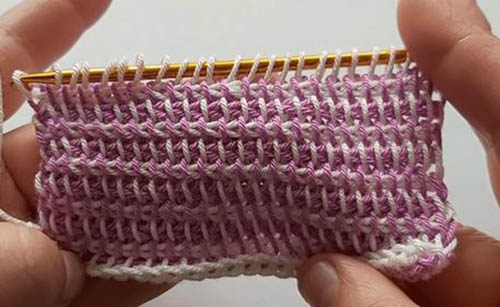
Knitting occurs in the following order.
- A chain of air loops is collected from light-colored threads. The length of this chain should match the required width of the finished fabric. When the required number of loops has been collected, a half loop is pulled through and all the resulting loops are left on the hook. Proceed to the main knitting.
- Add a thread of a different color, which becomes the working thread. Make a loop, put it on the hook at the very beginning of the row (do not break the thread from the previous row). Grab the working thread, pull it through 2 loops together and leave it on the hook (2 pulled loops are under the hook). Continue closing the loops in this way, removing them from the hook. At the end of the row, 1 new loop will remain.
- The fabric is not turned over - it is moved in the opposite direction. The hook is inserted under the vertical loop, the knitted working thread is picked up and pulled out. This algorithm is continued, again picking up loops on the hook. At the end of the row, the number of loops will be equal to the number of chain links and 1 additional loop. Here, the ends of 2 different threads are on one side. To change the color, change the working thread.
The length of the fabric is adjusted independently. The frequency of changing the colored thread is determined to your taste. The pattern and texture of the knitted fabric remains unchanged.
Secrets for Beginners
- To determine how a pattern of 2 colors of thread will look, they knit a small piece of the pattern. This is how the desired pattern is selected. It is easier for beginners to decide on a simpler pattern if they have not worked with any of the selected patterns before.
- When knitting in the Tunisian style, the hook is held like a knitting needle.
- The pattern and the canvas itself can be distorted due to incorrect hand positioning. Then the threads are not pulled tightly and the columns are of different sizes. Therefore, hands and tools are moved smoothly, in a single rhythm, the thread is unwound freely and gradually.
- The pattern may be distorted if the number of loops is not observed. To avoid this, count the loops during knitting, or count them in each row.
- The yarn is wound with the free hand without a hook. The end of the working thread passes through the index finger and slides through the fingers.
- To change the tension of the yarn, wrap the working thread around other fingers or twice around the index finger.
- To prevent the thread from twisting during knitting, pull the thread from the middle of the skein and knit with it. Secure the loose thread so that it does not interfere during knitting. Some also rewind the entire skein of yarn themselves, if time allows.
- To better see the loops when working with dark yarn, use a white or light base, which is placed under the fabric.
- If a mistake is made in a row, it is unraveled to the beginning and knitted again, otherwise it will be noticeable throughout the pattern in the finished product.
- Despite the prevalence of knitting, not all patterns have the same description, so they are always guided by the description of the work and decoding of the symbols.
Schemes and descriptions of two-color crochet patterns help beginner knitters or those who are getting acquainted with new patterns. If you know some tricks or follow the advice of experienced craftswomen, the process will be faster, and the knitted fabric will be neater.
Video about knitting
Two-color crochet pattern "Honeycomb":
